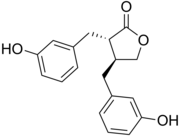Enterolactone
 |
|
| Names | |
|---|---|
|
IUPAC name
(3R,4R)-3,4-bis[(3-hydroxyphenyl)methyl]oxolan-2-one
|
|
| Other names
(−)-Enterolactone
|
|
| Identifiers | |
|
3D model (JSmol)
|
|
| Abbreviations | ENL |
| ECHA InfoCard | 100.162.708 |
|
PubChem CID
|
|
|
|
| Properties | |
| C18H18O4 | |
| Molar mass | 298.34 g·mol−1 |
|
Except where otherwise noted, data are given for materials in their standard state (at 25 °C [77 °F], 100 kPa).
|
|
|
|
|
| Infobox references | |
Enterolactone is a mammalian lignan formed by the action of intestinal bacteria from plant lignan precursors present in the diet.
Many dietary plant lignan precursors, such as secoisolariciresinol, matairesinol, lariciresinol, pinoresinol and sesamin, can be metabolized by gut microbes to enterolactone. In edible plants lignans are bound to the fiber fraction and therefore fiber-rich food products, such as cereals, vegetables, fruits and berries, are generally good sources of lignans and enterolactone. The richest known dietary sources of enterolactone precursors are flaxseed and sesame seed. Since enterolactone is produced by specific species of gut microbiota, the capacity to produce it varies between people. Antibiotic treatments can abolish the capacity to produce enterolactone. It may take up to a year before enterolactone production is restored.
Enterolactone is suggested to possess beneficial health effects in humans. In epidemiological studies lower concentrations of enterolactone have been observed in breast cancer patients compared to healthy controls, which may suggest that enterolactone is anti-carcinogenic. Enterolactone and lignans may also be protective of cardiovascular disease.
...
Wikipedia
